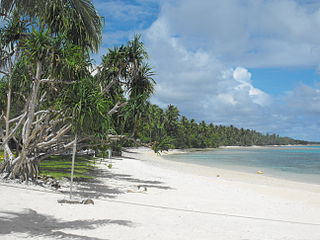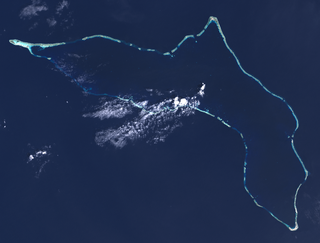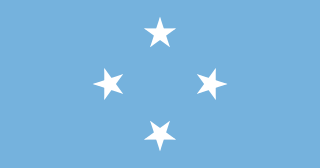
The Marshall Islands, officially the Republic of the Marshall Islands, is an island country west of the International Date Line and north of the equator in the Micronesia region of the Northwestern Pacific Ocean.
Austronesian settlers arrived in the Marshall Islands in the 2nd millennium BC, but there are no historical or oral records of that period. Over time, the Marshallese people learned to navigate over long ocean distances by walap canoe using traditional stick charts.

Majuro is the capital and largest city of the Marshall Islands. It is also a large coral atoll of 64 islands in the Pacific Ocean. It forms a legislative district of the Ratak (Sunrise) Chain of the Marshall Islands. The atoll has a land area of 9.7 square kilometers (3.7 sq mi) and encloses a lagoon of 295 square kilometers (114 sq mi). As with other atolls in the Marshall Islands, Majuro consists of narrow land masses. It has a tropical trade wind climate, with an average temperature of 27 °C (81 °F).

Kwajalein Atoll is part of the Republic of the Marshall Islands (RMI). The southernmost and largest island in the atoll is named Kwajalein Island, which its majority English-speaking residents often use the shortened name, Kwaj. The total land area of the atoll amounts to just over 6 square miles (16 km2). It lies in the Ralik Chain, 2,100 nautical miles southwest of Honolulu, Hawaii.

Bikini Atoll, known as Eschscholtz Atoll between the 19th century and 1946, is a coral reef in the Marshall Islands consisting of 23 islands surrounding a 229.4-square-mile (594.1 km2) central lagoon. The atoll is at the northern end of the Ralik Chain, approximately 530 miles (850 km) northwest of the capital Majuro.

Jaluit Atoll is a large coral atoll of 91 islands in the Pacific Ocean and forms a legislative district of the Ralik Chain of the Republic of the Marshall Islands. Its total land area is 11.34 square kilometers (4.38 sq mi), and it encloses a lagoon with an area of 690 square kilometers (270 sq mi). Most of the land area is on the largest islet (motu) of Jaluit (10.4 km2). Jaluit is approximately 220 kilometers (140 mi) southwest of Majuro. Jaluit Atoll is a designated conservation area and Ramsar Wetland.

The South Seas Mandate, officially the Mandate for the German Possessions in the Pacific Ocean Lying North of the Equator, was a League of Nations mandate in the "South Seas" given to the Empire of Japan by the League of Nations following World War I. The mandate consisted of islands in the north Pacific Ocean that had been part of German New Guinea within the German colonial empire until they were occupied by Japan during World War I. Japan governed the islands under the mandate as part of the Japanese colonial empire until World War II, when the United States captured the islands. The islands then became the United Nations-established Trust Territory of the Pacific Islands governed by the United States. The islands are now part of Palau, the Northern Mariana Islands, the Federated States of Micronesia, and the Republic of the Marshall Islands.

Ebon Atoll is a coral atoll of 22 islands in the Pacific Ocean, forming a legislative district of the Ralik Chain of the Marshall Islands. Its land area is 5.75 square kilometers (2.22 sq mi), and it encloses a deep lagoon with an area of 104 square kilometers (40 sq mi). A winding passage, the Ebon Channel, leads to the lagoon from the southwest edge of the atoll. Ebon Atoll is approximately 155 kilometers (96 mi) south of Jaluit, and it is the southernmost land mass of the Marshall Islands, on the southern extremity of the Ralik Chain. In documents and accounts from the 1800s, it was also known as Boston, Covell's Group, Fourteen Islands, and Linnez.

Bikar Atoll is an uninhabited atoll in the Ratak Chain of the Marshall Islands. It is one of the smallest atolls in the Marshalls. Due to its relative isolation from the main islands in the group, Bikar's flora and fauna has been able to exist in a relatively pristine condition.

The following is an alphabetical list of topics related to the Marshall Islands.
There is a small Japanese community in the Pacific Island country of Palau, which mainly consists of Japanese expatriates residing in Palau over a long-term basis. A few Japanese expatriates started to reside in Palau after it gained independence in 1994, and established long-term businesses in the country. Japanese settlement in Palau dates back to the early 19th century, although large scale Japanese migration to Palau did not occur until the 1920s, when Palau came under Japanese rule and administered as part of the South Seas Mandate. Japanese settlers took on leading administrative roles in the Japanese colonial government, and developed Palau's economy. After the Japanese surrender in 1945, virtually all of the Japanese population was repatriated back to Japan, although people of mixed Japanese-Palauan descent were allowed to remain behind. People of Japanese-Palauan descent constitute a large minority of Palau's population as a result of substantial intermarriage between the Japanese settlers and Palauans. They generally identify with, conforming to cultural norms and daily lives with the Palauans.

Japanese Micronesians, also Nikkei Micronesians or Micronesians of Japanese descent, refers to citizens of the Federated States of Micronesia (FSM) who are of Japanese descent and are members of the Japanese global diaspora known as the Nikkei (日系).
Large-scale Japanese settlement in Micronesia occurred in the first half of the 20th century when Imperial Japan colonised much of Micronesia.
Mori Koben was a Japanese businessman and adventurer, who was best remembered as one of the first Japanese pioneers in Micronesia. As a young man, Mori migrated from Japan to Chuuk, where he helped to establish Japanese businesses in Micronesia. Mori's guidance and direction helped to expand Japanese business interests throughout Micronesia during the Spanish and German colonial-era. After Japan annexed Micronesia from Germany in 1914, Mori was hired as an adviser to the Japanese administration in the South Seas Mandate, and was instrumental in encouraging Japanese settlement in Micronesia. In his final years during World War II, Mori facilitated Micronesian support in the Japanese war efforts, but was already suffering from failing health from old age. He died within a few days after the Japanese surrender, and a sizeable minority of Micronesians with Japanese ancestry from Chuuk trace their ancestry back to Mori.

Kabua the Great, also Kabua Laplap, was a Marshallese iroij whom the German Empire recognized as the king of the Marshall Islands. From 1863 until his death in 1910, he claimed to be the paramount chief, or iroijlaplap, of the Ralik Chain, though his cousin Loiak also claimed the title. Kabua worked with western missionaries and copra traders to expand his wealth and political power. He was also one of the several Marshallese iroij to sign treaties with the German Empire, first granting Germans exclusive trading rights in the Marshalls in 1878 and then legitimizing German annexation of the islands as a protectorate in 1885. The German treaties recognized Kabua as King of the Marshall Islands, though the German anthropologist Augustin Krämer noted that "Kabua is king only by the grace of the Germans."

Delap-Uliga-Djarrit is an urban area in Majuro, the capital and the largest city of the Marshall Islands, with 15,846 people out of Majuro's 23,676. It consists of the districts of Delap, Uliga, and Djarrit. DUD is located on the eastern end of Majuro Atoll. Marshallese government buildings are situated in DUD.

Casten Ned Nemra is a Marshallese politician who was President of the Marshall Islands for 17 days in January 2016. He was elected by the Nitijeļā (Parliament) as President in January 2016, following the 2015 general election, narrowly defeating Senator Alvin Jacklick, a seven-term member of Parliament, by a 17–16 vote. He was the youngest person to hold the job and the second commoner. He was ousted by a vote of no confidence after just two weeks in office by the opposition for jumping ship and joining Iroij Mike Kabua's Aelon Kein Ad party along with Senators Dennis Momotaro and Daisy-Alik Momotaro.
Marshallese nationality law is regulated by the Marshallese Constitution of 1979, as amended; the 1984 Citizenship Act of the Marshall Islands, and its revisions; and international agreements entered into by the Marshallese government. These laws determine who is, or is eligible to be, a national of the Marshall Islands. The legal means to acquire nationality, formal membership in a nation, differ from the domestic relationship of rights and obligations between a national and the nation, known as citizenship. Marshallese nationality is typically obtained either on the principle of jus soli, i.e. by birth in the Marshall Islands or under the rules of jus sanguinis, i.e. by birth abroad to parents with Marshallese nationality. It can be granted to persons with an affiliation to the country, or to a permanent resident who has lived in the country for a given period of time through naturalization.
Mary Heine Lanwi is an educator, activist, and promotor of traditional handicrafts in the Marshall Islands. A female pioneer on the islands, she has been described as "perhaps the first Marshallese woman to begin employment outside the home." In 1974, she was the only woman elected to serve as a delegate to the Micronesian Constitutional Convention.

Naval Base Marshall Islands were United States Navy advance bases built on the Marshall Islands during World War II to support the Pacific War efforts. The bases were built by US Navy after the Marshall Islands campaign that captured the islands from the Empire of Japan. By February 1944 the United States Armed Forces had captured the islands. Most of the airfields and other facilities Japan had built were destroyed in allied bombing raids and naval bombardment. US Navy Seabee Construction Battalions arrived as soon as the area was secured and remove the debris. The Seabees quickly repaired, built and improved the airfield/runways and seaport. Seabees often worked around the clock to get airfields operational so that fighter aircraft and bombers could start operating. The bases were used for staging upcoming campaigns and for repair.















